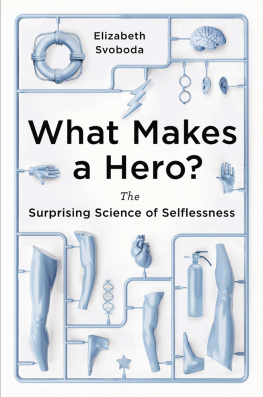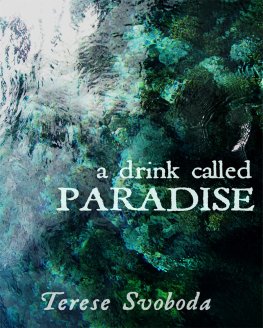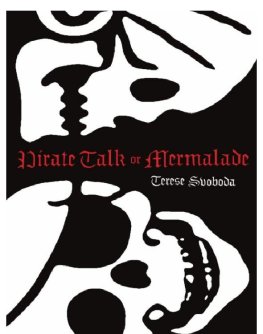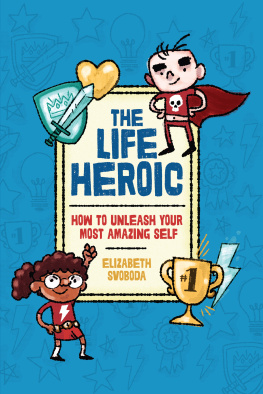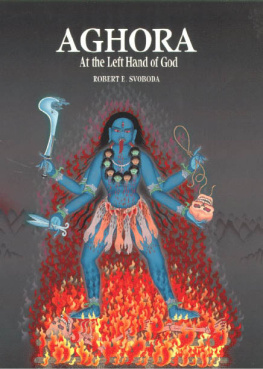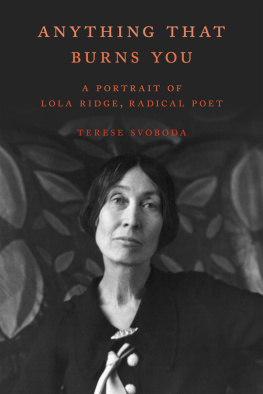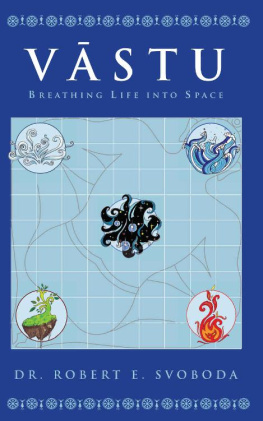Svoboda - Tao and Dharma
Here you can read online Svoboda - Tao and Dharma full text of the book (entire story) in english for free. Download pdf and epub, get meaning, cover and reviews about this ebook. publisher: Lotus Press, genre: Religion. Description of the work, (preface) as well as reviews are available. Best literature library LitArk.com created for fans of good reading and offers a wide selection of genres:
Romance novel
Science fiction
Adventure
Detective
Science
History
Home and family
Prose
Art
Politics
Computer
Non-fiction
Religion
Business
Children
Humor
Choose a favorite category and find really read worthwhile books. Enjoy immersion in the world of imagination, feel the emotions of the characters or learn something new for yourself, make an fascinating discovery.

- Book:Tao and Dharma
- Author:
- Publisher:Lotus Press
- Genre:
- Rating:5 / 5
- Favourites:Add to favourites
- Your mark:
- 100
- 1
- 2
- 3
- 4
- 5
Tao and Dharma: summary, description and annotation
We offer to read an annotation, description, summary or preface (depends on what the author of the book "Tao and Dharma" wrote himself). If you haven't found the necessary information about the book — write in the comments, we will try to find it.
Svoboda: author's other books
Who wrote Tao and Dharma? Find out the surname, the name of the author of the book and a list of all author's works by series.
Tao and Dharma — read online for free the complete book (whole text) full work
Below is the text of the book, divided by pages. System saving the place of the last page read, allows you to conveniently read the book "Tao and Dharma" online for free, without having to search again every time where you left off. Put a bookmark, and you can go to the page where you finished reading at any time.
Font size:
Interval:
Bookmark:
Arnie Lade is an acupuncturist practising in Victoria, British Columbia where he lives with his wife and children. He studied Chinese language at the University of Victoria and Xiamen University, and acupuncture and oriental medicine at the Beijing and Chengdu Colleges of Traditional Chinese Medicine in China. He is also the author of The Acupuncture Points: Images & Functions, a standard teaching text in its field, and is a contributing author of Chinese Massage Therapy. Mr. Lade lectures widely and is currently on the faculty of the Centro de Estudos de Medicina Oriental de Brasilia in Brazil.
Robert Svoboda graduated from the Tilak Ayurvedic College of the University of Poona in 1980 as the first and, and until today, the only Westerner ever to become a licensed Ayurvedic physician. Since then he has travelled extensively, lecturing and conducting workshops on Ayurveda. Among his writings are Prakruti: Your Ayurvedic Constitution and Ayurveda: Life Health and Longevity. Mr. Svoboda is on the staff of the Ayurvedic Institute in Albuquerque, New Mexico, and divides his time principally between North America, Hawaii and India.
by Arnie Lade
An in-depth discussion of the derivation and clinical applications of hundreds of the most commonly used acupuncture points. In this richly-researched book prepared in consultation with leading Chinese scholars, Mr. Lade provides the images and functions, location, classifications, indications and contraindications for each of the points. An extensive repertory of traditional functions and patterns with their associated points enables the practitioner to move quickly from diagnosis to prescription of appropriate points.
There is also a Chinese character dictionary which defines the Chinese characters used in identifying point names. In addition, an index is included in which points are arranged by channel, alphanumeric number, pinyin, and English for easy reference.
364 pages, 6x9 hb cloth $29.50
original brush calligraphy
ISBN 0-939616-08-4
To order: contact EASTLAND PRESS
1260 Activity Drive, Suite A
Vista, CA 92083
ph. 800/453-3278
The authors wish to thank James Williams, Michael Tierra and Fred Smith for their gracious reviews of this book during its development. Special thanks to Diane Lade for providing the fine illustrations of plants that appear in Appendix I.
China and India have traded and exchanged much information on the use of plants, minerals and animal products for food and medicinal purposes over their long history. The merchants, priests and scholars who over the past two millennia sought new sources of medicines undoubtedly exchanged information about each cultures use of drugs. About a quarter of the plants listed in the Chinese classic Compendium of Materia Medica {Ben Cao Gang Mu), which was written in 1590 A.D. by Li Shi Zhen and was considered the most extensive materia medica in its time, are common to both India and China. Many of the plants listed in this Chinese materia medica were in fact imported from India. Trade and information historically also went the other way, over the Himalayas to influence Ayurvedas formulations, and new medicinal substances are still being introduced into the market place in both India and China. Ginseng root, for example, is now being cultivated and sold in India.
In this appendix a representative group of twelve substances which are common to both traditions, ten of plant origin and one each from the mineral and animal kingdoms, is discussed from both perspectives. About half the drugs mentioned below are native to both countries, and the rest were originally trade commodities native to one or the other. This comparative survey includes a brief historical background, each drugs Latin, Sanskrit and Chinese names, and the part(s) of the source plant, mineral or animal which was traditionally used.
As will become evident hereafter, the Chinese and Ayurvedic systems categorized and utilized most medicinal substances in approximately similar ways. The general uniformity of opinion on the taste and temperature properties of the substances among both systems is perhaps due to the fact that both taste and temperature are deduced directly through sensory feedback and physical interaction with the substance. Those divergences of opinion which do occur may be partially explained by the subtle changes a plant goes through in adapting to a different habitat, and partially by the specific uses that each discipline emphasizes in accordance with its own medical paradigm. Also, the context of the whole materia medica affects how a substance may be emphasized, so that what is a minor remedy in one system may in the other be portrayed as an indispensable drug.
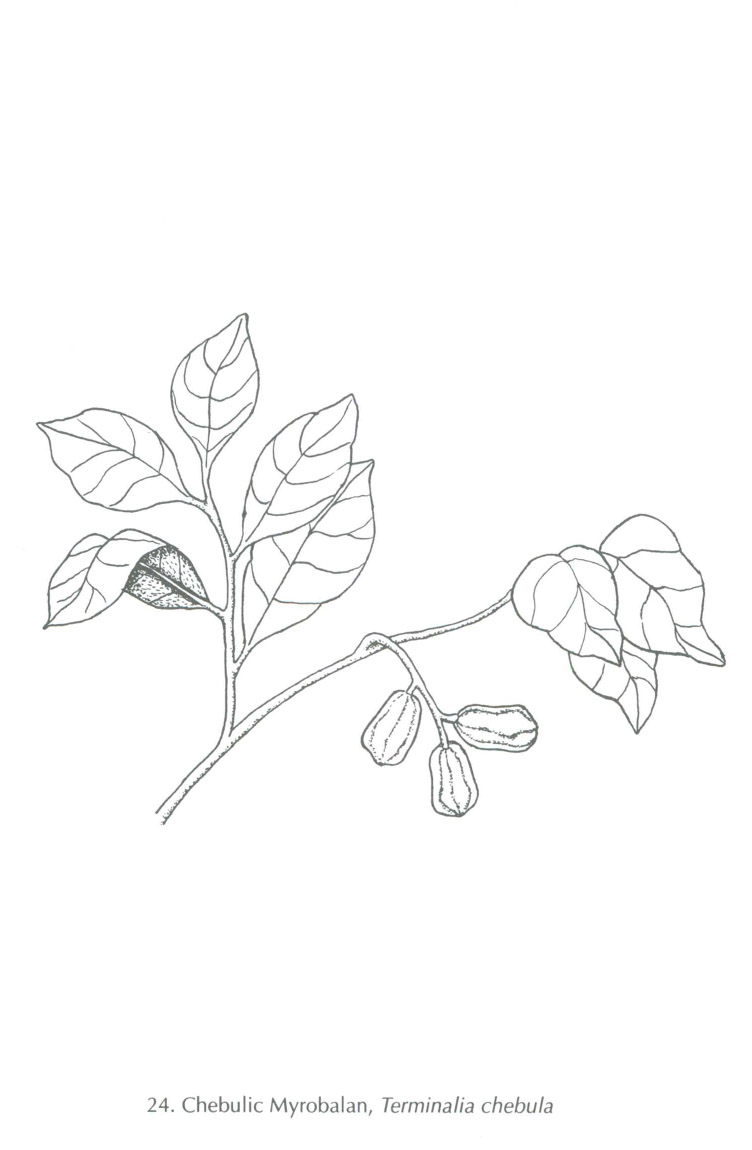

Chebulic myrobalan holds a position of high esteem in Ayurveda, perhaps its most important plant. Chebulic myrobalans Sanskrit name (haritaki) has the triple meaning of taking away all diseases (harayet), of being green in natural color (harita) and of growing in the abode of Lord Shiva (Hara), the Himalayas (considered the plants ideal habitat). Since Charakas time chebulic myrobalan fruit has been considered a powerful tonic and rejuvenative that never causes harm to a person who takes it. Chebulic myrobalan found favor wherever it went, in Greco-Roman, Tibetan, Chinese and Arabic medicine, being praised by Avicenna, the great 11th century Muslim physician, and extolled in the Four Tantras (Gyushi), Tibets preeminent medical text, as the king of medicines. So sacred is chebulic myrobalan to Tibetans that it is the Medicine Buddha is visualized holding in his extended right hand in a gesture of giving. Tibetan medicine utilizes every part of this plant for medicinal purposes.
Ayurveda utilizes not one but three myrobalans, however; the other two being Emblica officinalis (amalaki) and Terminalia belerica (bibhitaki). The three together form triphala ("three fruits"), a remedy par excellence for regulating and toning the digestive tract, and one of Ayurvedas foremost prescriptions. Ayurveda considers chebulic myrobalan calming to all Doshas, and especially beneficial for reducing Vata, for though the fruit is predominantly astringent in taste it is warming in its inherent attribute and its post-digestive effect is sweet. Chebulic myrobalans main therapeutic function is to scrape away digestive toxins from the digestive tract and the tissues (especially the blood). It is much used in abdominal distension, malabsorption, jaundice, tumors, urinary infections, edema, and in both constipation and diarrhea. Chebulic myrobalan is said to rejuvenate both the body (especially the colon and lungs) and mind, to impart wisdom and intelligence, and to increase longevity. This makes it ideal for use in chronic conditions such as asthma (in which case its jam is consumed or its coarse powder is smoked), prolapses of various organs, abnormal discharges (spermatorrhea, leucorrhea, and sweating), and bleeding gums.
Chebulic myrobalan was first mentioned in Chinese medicine in the Materia Medica of Medicinal Properties (Yao Xing Ben Cao), a text published around 600 A.D., as a fruit originating from India. Nowadays it is grown in the southern Chinese provinces of Yunnan, Guangdong and Guangxi. Chebulic myrobalan has no special status in Chinese medicine. It is said to bind up the intestines, and to be useful in treating dysentery and chronic diarrhea due to either internal heat or coldness (which is why Chinese medicine considers it to have a neutral temperature). Also, since chebulic myrobalan is said to contain the lungs Qi it is able to stop coughing, relieve asthma, and soothe the throat. Chinese medicine administers the fruit in the roasted form for intestinal symptoms, and in the raw form for respiratory complaints.
Font size:
Interval:
Bookmark:
Similar books «Tao and Dharma»
Look at similar books to Tao and Dharma. We have selected literature similar in name and meaning in the hope of providing readers with more options to find new, interesting, not yet read works.
Discussion, reviews of the book Tao and Dharma and just readers' own opinions. Leave your comments, write what you think about the work, its meaning or the main characters. Specify what exactly you liked and what you didn't like, and why you think so.

